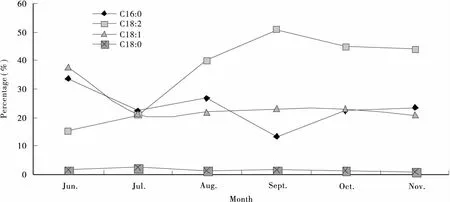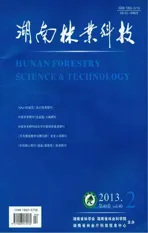光皮树果实生长发育及其脂肪酸积累研究
2013-11-18陈景震李昌珠李培旺张良波肖志红刘汝宽
陈景震, 李昌珠, 李培旺, 张良波, 肖志红, 刘汝宽
(湖南省林业科学院, 湖南 长沙 410004)
光皮树果实生长发育及其脂肪酸积累研究
陈景震, 李昌珠, 李培旺, 张良波, 肖志红, 刘汝宽
(湖南省林业科学院, 湖南 长沙 410004)
对光皮树果实大小、鲜干重、含水率、含油率及脂肪酸组成进行了研究,结果表明:光皮树果实在整个发育过程呈现“S”曲线变化,果实含油率最大可达到34.23%。果实发育初期含水率最高,而在果实发育后期主要是干物质的积累,含水率较低。在光皮树果实油中,硬脂酸含量最低,维持在2%左右,油酸亚油酸含量最高,不饱和脂肪酸含量在70%以上。整个发育过程,棕榈酸的含量一直降低,导致饱和脂肪酸的含量变化也是递减的。
光皮树; 果实发育; 脂肪酸组成
Energy plant-Swidawilsonianaare perennial deciduous trees and ideal plants of wild woody oil, which belong toCornaceaeCornusL[1]. They are distributed in the central south of China and are suitable for the barren, arid and limestone mountainous land[2]. According to the reports, fruit oil ofSwidawilsonianacan be the resource of biodiesel and cover the shortage of non-renewable energy resources[3]. The combustion of biodiesel is similar with that of 0#diesel, including safety(flash point more than 105 ℃) and environmental property (ash content less than 0.03 g/kg)[4]. The present work aims to study fruit growth and fatty acid accumulation pattern, as a basic data for reference.
1 Materials and methods
1.1Materials
The experiment had been completed in May 2006 in Hunan Academy of Forestry. 2~3 years oldSwidawilsonianagrafting plant with strong growth, normal results, representative were selected as observation and experimental standard.
1.2Methods
100 fruits of the above-mentioned plants were randomly selected, and measured every 7 days, when the fruit was appeared. Longitudinal and transverse of the fruit were measured by vernier caliper. Moisture content was measured with weight difference method, while Soxhlet extractor was used to measure oil content[5]. Oils component was analyzed by GC-2014 gas chromatograph[6].
2 Results and analysis
2.1Fruitshapechanges
From Fig.1,we could conclude that the fruit were grown more quickly from late May to mid June after flowers withering, mainly due to the fruit in the stage of cell division, in which the cell number increment was in dominant. From mid June to mid September, the growth rate was slower, and tended to be stable. The growth of vertical diameter and transverse diameter tended to synchronize. The period was a long duration, but the growth of transverse diameter was slightly less than vertical diameter. In the late of September, the fruit was grown rapidly, in which the growth of transverse diameter was greater than the vertical diameter, and gradually close to vertical diameter. The fruit shape was nearly circular, while the whole development showed s-curve.

Fig.1 The vertical diameter and transverse diameter change curve of fruit
2.2Fruitweight,moisturecontentandoilcontentchanges
Seen from Fig.2, in mid August, the weight of fresh fruit was grown significantly after flowers withering. It could be due to that the moisture content was higher. In the period of late August to mid September, the fresh weight and dry weight were increased slowly. At the end of September, the fresh weight and dry weight of the fruit were increased significantly, especially dry weight which net growth of up to 15.5 g, as a peak stage in which the accumulation of dry matter.

Fig.2 The fresh weight and dry weight change curve of fruit

Fig.3 The moisture content and oil content change curve of fruit
Fruit moisture content in the growth process was decreased. Initially fruits required a large amount of water in order to meet their growth. From Fig.3, we could see that the moisture content of fruit was decreased after maturation. Oil content was increased in the growth process, which especially in the end of October was singificantly. The maximum oil content was up to 34.23% after ripening.
2.3Fruitoils-componentchanges
Seen from Fig.4, in the fruit oil ofSwidawilsoniana, stearic acid content was lower as 2%. Oleic acid and linoleic acid contents were kept in a high level. Linoleic acid was increased singificantly. As Fig.5, the unsaturated fatty acid content was over 70%, while palmitic acid contents tended to downward, resulting in saturated fatty acid content decreased.

Fig.4 Various oils-component change curve of fruit

Fig.5 The fatty acid content change curve of fruit
From Fig.6 to Fig.11 were gas chromatograph atlases of the fruit oil ofSwidawilsonianain each month.

Fig.6 Gas chromatograph atlas in June

Fig.7 Gas chromatograph atlas in July

Fig.8 Gas chromatograph atlas in Aug

Fig.9 Gas chromatograph atlas in Sep.

Fig.10 Gas chromatograph atlas in Oct.

Fig.11 Gas chromatograph atlas in Nov.
3 Conclusions
After flowers withering, the fruit were grown more quickly from late May to mid June, mainly due to the fruit in the stage of cell division. From mid June to mid September, the growth rate was slower, and tended to be stable. In the late of September, the fruit was grown rapidly. The whole development process ofSwidawilsonianafruit was shown as an s-curve.
At the beginning, the moisture content of fruit was higher and the fresh weight was grown significantly because fruits required a large amount of water in order to meet their growth. The accumulation of dry matter mainly concentrated in the late stage of fruit growth.
The maximum oil content was up to 34.23% after ripening. In the fruit oil ofSwidawilsoniana, stearic acid content was lower as 2%. Oleic acid and linoleic acid contents were kept in a high level. The unsaturated fatty acid content was over 70%.
[1] CHENG Xunyan.Swidawilsonianaare precious woody oil resources[J]. Biological and Specialty Products, 1990(6): 28.
[2] ZENG Yichun, PAN Jinxiang. The afforestation tree species of limestone mountain-Swidawilsoniana[J]. Hunan Environment Biology Profession Technology College Journals, 2001, 7(4):10-12.
[3] LI Dangxun, LI Changzhu. Propagation techniques ofSwidawilsonianaWanyer as a kind of feedstock of fuel-oil plant[J]. China Forestry Science and Technology, 2005,19 (3):33-35.
[4] LI Zhengmao, DENG Xinhua. Development conception of economic characteristics and biomass liquid fuel ofSwidawilsoniana[J]. Hunan Forestry Science and Technology, 1996, 23(2).:11-13.
[5] Li H Z , Lester P , Jochen W. High intensity ultrasound-assisted extraction of oil from soybeans[J]. Food Research International , 2004,37(7) : 731-738.
[6] ZENG Hongyan. GC-MS of the oils fromSwidawilsoniana’seeds with different methods[J]. China Biotechnloogy, 2004,24 (11):11.
(文字编校:张 珉)
FruitdevelopmentandfattyacidaccumulationofSwidawilsoniana
CHEN Jingzhen, LI Changzhu, LI Peiwang,ZHANG Liangbo, XIAO Zhihong, LIU Rukuan
(Hunan Academy of Forestry, Changsha 410004, China)
The fruit shape, fresh and dry weight and oils-component changes ofSwidawilsonianain the whole development process were studied. The results showed that, the whole development process ofSwidawilsonianafruit was shown as an s-curve and the maximum oil content ofSwidawilsonianafruit was up to 34.23% after ripening. The moisture content was higher in the beginning, then the accumulation of dry matter was mainly concentrated in the late stage of fruit growth. In the fruit oil ofSwidawilsoniana, the yield of stearic acid was low, which was around 2%. Oleic acid and linoleic acid contents were higher, while unsaturated fatty acid content was over 70%. In the development period, palmitic acid content tended to downward, resulting in the decrement of saturated fatty acid content.
Swidawilsoniana; fruit development; fatty acid component
2012-12-18
2013-03-08
国家“十二五”科技支撑(2011BAD38B075)
S 565.9
A
1003-5710(2013)02-0009-06
10. 3969/j. issn. 1003-5710. 2013. 02. 003
